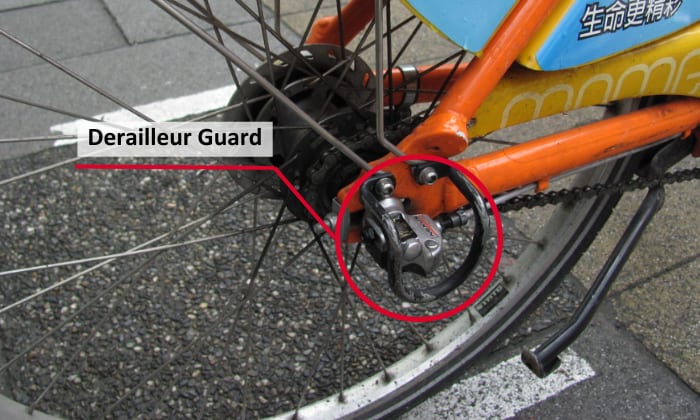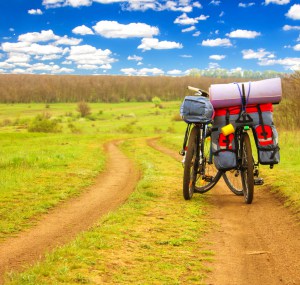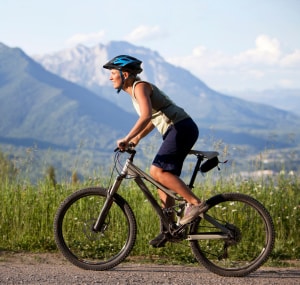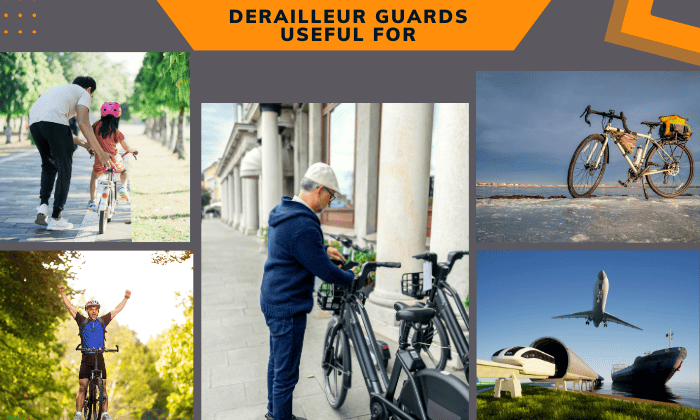A derailleur guard, also known as a derailleur protector or hanger guard, safeguards the rear derailleur on a bike from potential damage caused by impacts, collisions, and other obstacles.
Whether a derailleur guard is a must-have accessory for your biking adventures depends on various factors. Things such as riding style, skill level, cost, and bike type, should all be considered to make an informed decision.
So, as a cyclist, do you need a derailleur guard? The quick answer is “yes” but in certain cases. Let’s learn more about derailleur guards and find out if you need one for your next ride!
Table of Contents
What’s a Derailleur Guard?
A bike derailleur is a key component of a bicycle’s drivetrain system. It allows shifting the chain across different gears to adjust pedaling resistance and maintain proper pressure on the chain.
Derailleurs are prone to damage, especially on lower-end and beginner bikes, where cheap derailleurs are customary. That’s why you typically see entry-level bicycles come with extra components such as derailleur guards and spoke protectors.
A derailleur guard is designed to protect the rear derailleur from potential damage. It is typically made of durable material and is attached to the derailleur hanger or dropout area of the bike frame.
The derailleur guard shields the delicate and exposed rear derailleur mechanism from collisions, rocks, branches, and any obstacles encountered during riding. Without this barrier, the derailleur could suffer from severe damage that leads to shifting issues or even render the bike inoperable.
Do You Need a Derailleur Guard?
To determine if you need a derailleur protector for bikes, you would need to consider a few things. There are a few situations and factors wherein you will know if you do need one. Here are a few:
1. Riding style
Riding style matters most when it comes to selecting your bike and determining what parts you need, this includes derailleur guards. When it comes to short, everyday distances, it would be less of a problem. However, that isn’t the case for long and rough rides.
Bike derailleur guards are commonly found on bikes where heavy luggage and rough terrains are a go-to. Since they could be battered easily or are prone to lateral falls, you should consider a derailleur guard for a bike you use when traveling long distances.
2. Skill level
Most bike derailleurs are only necessary for beginners, where rough stops and falls are more common than the average bike.
As the cyclist grows and gains more experience, they receive less falls and improve their balance and skills. With their performance, their bikes can also improve and change, especially kids’ bikes or public rental bikes used for practice.
Beginner cyclists need derailleur guards on their bikes. However, they can also grow out of them in due time and practice. A temporary and affordable guard would be ideal for this situation.
3. Cost and weight
Your bike’s quality often differs depending on its price. Cheaper bikes also contain cheap derailleurs that may be prone to delicate accidents as well. Furthermore, heavy bikes can also be prone to derailleur damage when exerting too much pedaling effort.
Derailleur guards would help keep the chains and gears intact while using these affordable bikes, especially on long and rough rides and tours.
4. Bike type
Mountain bikes would be a common type which would need a bike derailleur, since they’re often used for rocky, irregular terrains and long distances. Bumpy roads can lead to small accidents, and that’s where derailleur guards come in.
Off-terrain bikes such as MTBs, Hybrids, and Trekking bikes would be in need of a derailleur protector while traveling to keep the gears and chains in one piece.
Why Are Derailleur Guards Unnecessary for High-end Bikes?
Higher-end bikes don’t often feature derailleur guards for a few reasons:
1. Modern, newer bikes have different builds
Most modern bikes’ rear derailleurs are attached to the bike frame via a derailleur hanger made from softer aluminum material. They bend before the chainstay and derailleur and prevent any damage to the expensive parts.
Aside from new derailleur hangers, the derailleurs featured on recent bikes have a low profile and are positioned in a more protected area. These bikes include the Shimano which has recently featured Zee derailleurs that are ideal for heavy-duty mountain biking.
2. They add more weight to the bike
Weight is an important aspect of cycling, wherein any additional or heavy load put on the bike could slow down the cyclist or make it difficult to pedal the bike itself. A rear derailleur poses an extra 50-100 grams that could easily affect the bike.
3. They don’t entirely protect the bike
Derailleur guards are ideal for protecting the mechanics from low-impact lateral falls and impacts from the side. It’s still possible for the derailleur to be hit by a branch or rock under the low pulley or the derailleur’s cage.
4. Derailleur guards’ builds are at a disadvantage
From the way they look and the way they stick out, a derailleur guard may be able to pick up external objects from the rear, hence it’s a piece of equipment avoided by mountain bikers and other competitive, touring bikes that trail rough terrains.
Derailleur guards can also be attached to the frame and could endanger the frame’s rear triangle, especially when made with aluminum and carbon materials.
Despite these, some bikes still have derailleur guards to help beginners and learners who would like to try and build up their skills with a high-end bike.
So even with top-tier bikes like a Shimano or a Huffy where derailleur replacements are pricey, derailleur guards are still necessary for people who want to grow into these durable, high-quality bikes.
What Situations Are Derailleur Guards Useful for?
There are a few things derailleur guard is needed, it would highly likely be needed in situations where the cyclist is still learning or during various situations such as:
1. Beginner bikes for kids
Learning kids can potentially ride rough and impact their bikes while they grow into them, hence the need for a derailleur guard in kids’ bikes is essential.
2. New cyclists
Beginners of any age need the best protection and equipment when learning how to ride a bike for the first time. Derailleur guards can help protect the bike and can keep the beginner safe from any chain issues.
3. Renting out or borrowing bikes
Shared bikes need extra protection, especially when used by strangers. To preserve the bike’s quality and for its continuous use, derailleur guards can keep the gears smooth and protected, ready for the next cyclist.
4. Touring with a bike
Touring bikes often face different impacts from trailing on various terrains and environments. They’re also loaded and weigh more from the cyclist’s trips. These bikes would need a derailleur guard in case of any fall or damage from these aspects.
5. Transporting your bikes
Whether it’s on a plane or a boat, bikes are ideal to have a derailleur guard installed. This is to keep the derailleur and chains from any potential damages while being transported on other vehicles. In this case, you can install the piece on an e-bike.
Frequently Asked Questions
Are Derailleur protectors that replace the quick-release nut good?
Yes, replacing the quick-release nut can be more efficient. It serves as a multipurpose accessory and functions as not just a quick-release nut and a derailleur guard, but also as an optimal light mount.
However, while some derailleur protectors work more efficiently when replacing the rear wheel’s quick-release nut, they come with a few disadvantages.
Some of these downsides include rendering the axle useless after a fall, being prone to damage when stepped on, and their inability to protect the entire derailleur’s body.
What is the purpose of a Derailleur Guard?
Derailleur guards protect the spokes that keep the bike chain in place. They’re especially useful for beginners, shared bikes, storage, and during bike transport as it keeps the derailleur and its hanger from any damage.
How do I protect my rear derailleur?
It’s common to worry about rear derailleurs, especially when storing bikes. Oftentimes, bikes could use a rear derailleur protector to keep the rear from any damage while the bike is in use, such as a Bontrager rear derailleur guard.
Stowing your bikes away, however, is different. To properly protect your rear derailleurs in storage, you have to remove it from the bike itself and carefully wrap it up with padding and store it in a safe place.
How can I install derailleur guards when my bike has no eyelet?
While your bike features no eyelet, you can still get a derailleur guard that attaches thru the axle. They usually have a hole at the top that can be installed onto the axle.
However, it does have its downsides. Attaching a derailleur guard thru the axle would also mean that you would have to remove the guard when pulling out the wheel. It would also mean you have to re-install the guard every time you need it.
Where can I get a derailleur guard?
Of course, bike derailleur guards are common to see in athletics and bike shops. It’s easy to find derailleur guards in Decathlon or derailleur guard in Halfords, as they’re also available online. The difference would mostly be the price, depending on where you get it.
Conclusion
A bike has different parts, and they all have a very specific purpose. The derailleur guard may present itself as an expendable part, but it’s still essential for learning cyclists and shared bikes.
So, to determine do you need a derailleur guard or not, consider your experience, terrain, and the people around you. These pieces of equipment can help you grow your bike and protect it as well.

“I ride my bike to work for years, but is that enough? Our carelessness towards our surroundings has taken a toll on the environment. And now, everyone is responsible for changes; even the most minor contribution is counted. With this hope and spirit, I started with my partner to establish Biketoworkday to help more individuals commute to their work sites on their bikes.”









